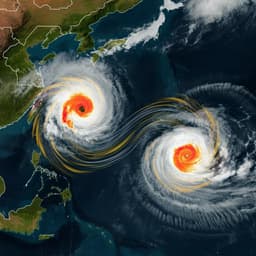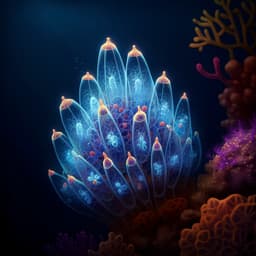
Earth Sciences
Ocean internal tides suppress tropical cyclones in the South China Sea
S. Guan, F. Jin, et al.
This research reveals surprising insights into Tropical Cyclones, particularly in the South China Sea, where conditions are ideal yet intensification remains low. Conducted by a team of experts including Shoude Guan, Fei-Fei Jin, and more, this study explores the unique interplay of ocean dynamics that challenges traditional cyclone forecasts.
~3 min • Beginner • English
Introduction
Tropical cyclones spend most of their lifetimes over the ocean, and their intensification strongly influences societal impacts at landfall. While TC track forecasts have improved, intensity forecasts lag behind. TC intensity is governed by internal dynamics and environmental factors including vertical wind shear, mid-tropospheric humidity, sea surface temperature (SST), and potential intensity. Ocean cooling induced by TCs can reduce enthalpy flux and inhibit intensification, and pre-existing ocean features (e.g., mesoscale eddies, barrier layers) can modulate this cooling. The SCS experiences frequent TCs, and prior work has emphasized genesis and interannual to decadal variability linked to the East Asia monsoon, ENSO, and the PDO. However, the intensification characteristics in the SCS and their environmental controls are not well understood. This study investigates why TCs intensify unusually weakly in the SCS despite seemingly favorable atmospheric and oceanic conditions, hypothesizing that powerful internal tides (ITs) in the SCS enhance TC-induced upper-ocean cooling and suppress intensification.
Literature Review
Prior studies identify key atmospheric controls on TC intensification such as vertical wind shear, humidity, SST, and potential intensity. Ocean feedbacks, particularly TC-induced SST cooling via entrainment and mixing, are a major negative factor and are modulated by ocean features like eddies and barrier layers. The SCS has been studied for TC genesis variability and monsoon/ENSO/PDO influences, but intensification characteristics remain under-examined. The SCS hosts some of the world’s most powerful internal tides generated by strong barotropic tides interacting with sharp topography at Luzon Strait; these diurnal and semidiurnal internal tides propagate and dissipate across the basin. Observations have shown that internal tides can interact linearly and nonlinearly with TC-generated near-inertial internal waves, transferring energy to smaller-scale waves, enhancing shear and turbulent mixing. This background suggests a plausible pathway by which ITs could amplify TC-induced cooling and thereby suppress TC intensification, a mechanism not previously quantified basin-wide for the SCS.
Methodology
- Basin-wise statistics (1979–2019): Using global TC best-track data (IBTRACS), the study computed for each 6-hourly TC track-point a 24-h intensification rate as the linear regression coefficient of maximum sustained winds over the current and next four 6-hourly points (24 h). Track-points within 100 km of land or with landfall within 24 h were excluded to avoid land effects. Rapid intensification (RI) probability and the percentage of intense TCs (Category 3–5) were computed using both case-based and track-point-based methods; track-point-based metrics are presented in the main text.
- Environmental factors: Climatological SST from satellites and WOA13, potential intensity (computed from Emanuel’s code using ECMWF Interim atmospheric profiles and WOA13 SST), vertical wind shear (200–850 hPa difference averaged within 500 km, ECMWF), and midlevel relative humidity (500–700 hPa) were composited by TC category and basin. Pre-TC SST was averaged over days −7 to −1 within 100 km of the TC center. TC-induced SST cooling was defined as mean SST over days 0–1 minus pre-TC SST, with robustness tests using alternative space-time windows. Surface enthalpy flux (sensible + latent) during TCs was estimated via bulk formulas using during-TC SST (pre-TC minus satellite-derived cooling scaled by a factor 0.5, range 0.3–0.7), near-surface air properties from ECMWF, and exchange coefficients (1.3×10⁻³).
- Basin-size and land effects: A fixed-window analysis compared intense TC percentages after extracting comparable track segments (genesis to 700–1518 km) across basins, accounting for the SCS’s smaller size. Land-proximity points were pre-excluded from intensification calculations.
- In situ dynamical comparisons with/without ITs: Upper-ocean current responses to TCs were contrasted using moored ADCP observations from the South China Sea Mooring Array (SCSMA; strong ITs) and NDBC buoys in the North Atlantic (NA; weak/no ITs) under similar TC forcing (max winds ~24 m s⁻¹, translation speed ~4–5 m s⁻¹, observation sites ~110–120 km to the right of track, outside mesoscale eddy regions). Hourly currents were high-pass filtered (48 h) to extract internal-wave motions. Power spectra of currents and vertical shear (upper 150 m) were computed over the TC and ~20 days after, and inverse Richardson number was estimated using climatological T–S profiles (WOA13) for stability assessment.
- Price-model experiments: A computationally efficient TC-induced mixing scheme (Price, 2009) was used to simulate SST cooling for 661 SCS 6-hourly track-points (1998/2000–2016) under two scenarios: without ITs and with ITs. The with-ITs scenario incorporated a typical SCS internal-tide vertical shear profile derived from moorings into the mixing-depth criterion, placing strong shear at ~70–100 m where TC–ocean interactions are most effective. Initial profiles were from WOA13 (TC season), constant salinity 33 psu.
- ROMS and coupled ROMS–WRF case study: A 3D ocean model (ROMS; 9 km, 40 vertical levels) covering the SCS (99°E–135°E, 10°S–30°N) simulated TC Megi (2010) with two experiments: (1) without ITs (TC wind forcing only), and (2) with ITs (TC winds plus barotropic tidal forcing at open boundaries using TPXO7.2 K1, O1, M1, S2 constituents to generate internal tides). Mixing strength and SST cooling were compared along a 21°N section near the storm track. ROMS outputs provided ocean-surface boundary conditions to drive an atmospheric WRF model (9 km, 35 levels) in two ensemble sets (with-ITs vs without-ITs SST), holding other forcings identical (from CFSR). Sensitivity of Megi’s intensity and rainfall to ITs-enhanced cooling was assessed.
- Spatial/seasonal modulation: Differences in IT strength and associated suppression were examined between north and south SCS using mooring-based IT energy fluxes and composites of SST cooling and intensification rate. Seasonal alignment of IT energy flux and TC occurrence was also evaluated.
Key Findings
- Weakest intensification in the SCS globally: Despite frequent TC occurrence, the SCS has the lowest intensification rate and lowest RI probability among all TC-active basins. Average intensification rate is ~1.4 m s⁻¹ day⁻¹ in the SCS vs ~2.6 m s⁻¹ day⁻¹ global average (excluding SCS). The probability of RI is about 2% in the SCS vs about 7% elsewhere, and the percentage of intense (Category 3–5) TCs is about 3% in the SCS vs about 11% globally. At equivalent TC categories, the SCS intensification rate remains the lowest.
- Conventional environmental factors do not explain the weakness: The SCS exhibits among the highest pre-TC SST and second-highest potential intensity globally; vertical wind shear is not anomalously strong; midlevel relative humidity is the highest—conditions typically favorable for intensification.
- Extraordinary TC-induced cooling and reduced enthalpy flux in the SCS: For intense TCs, SCS SST cooling is ~80% stronger than the global average and surface enthalpy flux is ~33% lower. Even with moderate TC translation speeds and sizes (indistinguishable from other basins) and subsurface stratification weaker than the Eastern Pacific, the SCS cooling is 50–100% larger than in the EP for comparable TC attributes.
- Role of internal tides (ITs): In situ comparisons under similar TC forcing reveal that in the NA case (no strong ITs), near-inertial currents dominate with amplitudes up to ~0.4 m s⁻¹ and spectral peaks at f; in the SCS case (with strong ITs), additional diurnal/semidiurnal IT peaks and secondary waves (fD1, fD2, D2f) appear, with current amplitudes up to ~0.8 m s⁻¹. Total wave energy and shear variance are ~7 times larger in the SCS case, yielding higher inverse Richardson numbers and stronger entrainment. Resultant SST cooling in the SCS is stronger by ~0.5–1.0 °C than in the NA case.
- Modeling confirmation: Price-model experiments for 1998–2016 SCS TCs show that ignoring ITs underestimates cooling by ~34% (simulated 1.64 °C vs observed 2.47 °C), while including ITs yields 2.38 °C, close to observations. Accounting for ITs shifts the inferred during-TC enthalpy flux from comparable-to-global (without ITs) to the lowest among basins (with ITs).
- ROMS–WRF case (TC Megi, 2010): With-ITs simulations produce much stronger subsurface turbulent mixing and greater surface cooling than without-ITs, and coupled WRF runs show weakened TC intensity and rainfall when ITs are present.
- Spatial/seasonal modulation within the SCS: IT energy is ~6 times larger in the north vs south SCS; for intense TCs, SST cooling is ~0.5 °C larger and the magnitude of negative intensification rate is ~47% larger in the north. IT energy flux peaks in summer–autumn, aligning with peak typhoon season, potentially maximizing suppression.
- Broader relevance: The Coral Sea (South Pacific), another strong-IT region, also shows enhanced cooling (~2.2 °C) and reduced intensification (rate ~11 m s⁻¹ day⁻¹; lower intense-TC percentage) relative to global averages, suggesting wider applicability of the mechanism.
Discussion
The analyses demonstrate that the SCS’s uniquely weak TC intensification is not attributable to standard atmospheric or oceanic metrics (SST, potential intensity, shear, humidity, TC structure or speed). Instead, powerful internal tides interact with TC-generated near-inertial waves, amplifying shear, turbulence, and entrainment at depths (~70–100 m) optimal for cooling the mixed layer beneath TCs. This enhanced cooling curtails surface enthalpy flux to the storm, suppressing intensification. In situ observations, simplified (Price) and 3D coupled (ROMS–WRF) modeling consistently support the mechanism. Spatial variations in IT energy within the SCS (stronger in the north) and seasonal phasing with typhoon season modulate suppression intensity. The results imply that operational intensity forecasts can improve by explicitly representing IT–TC interactions in coupled models, especially in strong-IT regions. The study connects lunar-driven tides to weather-scale phenomena, offering a mechanistic link with societal implications for coastal populations.
Conclusion
This work establishes internal tides as a key oceanic control suppressing TC intensification in the South China Sea. By quantifying basin-wide intensification statistics, diagnosing environmental controls, comparing in situ dynamical responses with/without ITs, and validating with both simplified and fully coupled models, the study shows that IT–near-inertial wave interactions substantially enhance TC-induced cooling and reduce enthalpy flux, thereby weakening TC intensification. Incorporating internal tides and their interactions into operational coupled prediction systems is a clear pathway to improve TC intensity forecasts in the SCS and other strong-IT regions. Future work should: (1) develop parameterizations of IT–TC interactions suitable for forecast models, (2) expand observational networks to sample IT variability and TC–ocean coupling in multiple basins (e.g., Coral Sea, Indonesian seas, Hawaiian Ridge), (3) investigate impacts on a broader spectrum of weather phenomena (e.g., monsoon systems, fronts, MJO), and (4) assess climate-scale variability in IT strength and its implications for TC risk.
Limitations
- In situ comparisons rely on a small number of well-matched TC cases with subsurface current measurements; broader observational sampling is limited.
- Stability metrics used climatological temperature–salinity profiles due to a lack of continuous in situ profiles during the TC passages, introducing uncertainty.
- Satellite microwave SST can overestimate under-core cooling; during-TC SST was adjusted using an empirical 0.5 factor (range 0.3–0.7), contributing uncertainty to flux estimates.
- The ROMS–WRF assessment centers on a single case (TC Megi, 2010); while consistent with theory and statistics, more case studies are desirable.
- Internal tide strength is spatially and seasonally variable; representing this variability in forecast models remains challenging.
Related Publications
Explore these studies to deepen your understanding of the subject.







